Trees Birds Mammals Fish Amphibians Reptiles
Wild Algarve
Bookshop
Mycena inclinata (Fr.) Quél. - Clustered Bonnet
Phylum: Basidiomycota - Class: Agaricomycetes - Order: Agaricales - Family: Mycenaceae
Distribution - Taxonomic History - Etymology - Identification - Culinary Notes - Reference Sources
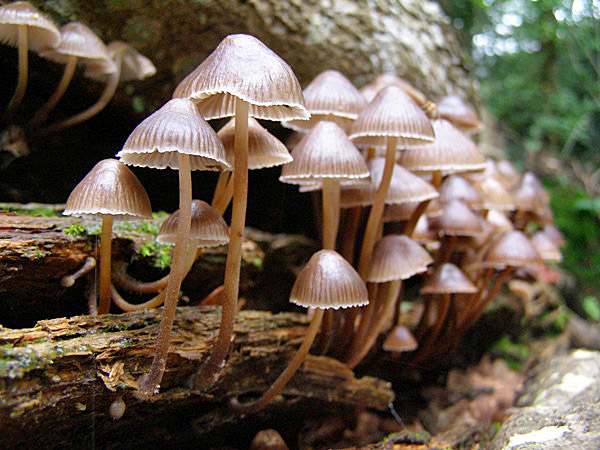
Nearly always found on oak roots, stumps or fallen trunks and branches or on dead parts of standing oak trees, the Clustered Bonnet is still referred to by some people as the Oak Bonnet. It has (depending on your nose!) either a spicy or a rancid odour that helps distinguish it from the many similar bonnet mushrooms.
The crenelate (scalloped) cap margin and white woolly base of the stem are features that help separate this bonnet from several others of similar size and equally varied range of colours.
Distribution
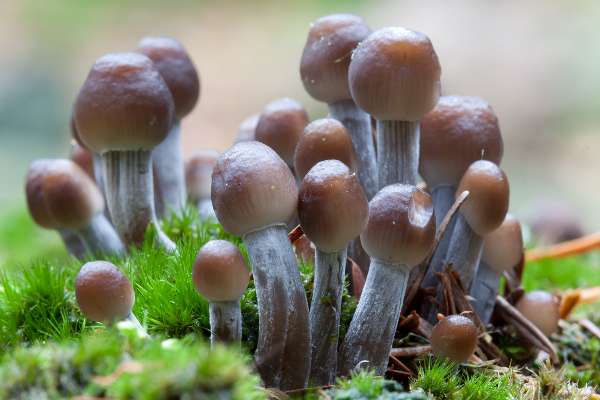
As you might expect from its English name, the Clustered Bonnet occurs in bunched groups more often than singly, and it is found throughout Britain and Ireland wherever oak trees live... or more accurately where they die. Globally Mycena inclinata is found throughout the northern hemisphere and much of the southern hemisphere too. This species is widespread across mainland Europe, particularly in northern and central countries, and it is recorded from many parts of North Africa, Asia, North America and Australasia.
Taxonomic history
The basionym of this species was defined when, in 1838, the great Swedish mycologist Elias Magnus Fries described the Clustered Bonnet and named it Agaricus inclinatus. Famous french mycologist Lucien Quélet transferred this species to its present genus Mycena in 1872, thereby establishing its currently accepted scientific name Mycena inclinata.
Synonyms of Mycena inclinata include Agaricus inclinatus Fr., Agaricus galericulatus var. calopus Fr., and Mycena galericulata var. calopus (Fr.) P. Karst.
Etymology
The specific epithet inclinata comes from Latin and means 'curved inwards' or 'sloping inwards', as the stem bases invariably are when these bonnet mushrooms form clusters.
Identification guide
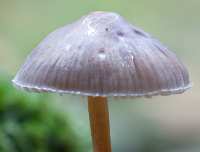 |
Cap
2 to 3.5cm across; conical, becoming bell shaped and eventually broadly umbonate; smooth with striations almost to centre; margin scalloped or sharply toothed; various shades of grey or greyish-brown, becoming darker towards the centre.
Stem
5 to 10cm long and 2 to 4mm in diameter.; white or pale brown at the apex, progressively darker red-brown towards the downy base; no stem ring. |
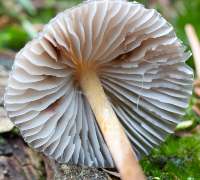 |
Gills
Adnate; white turning pinkish-grey.
|
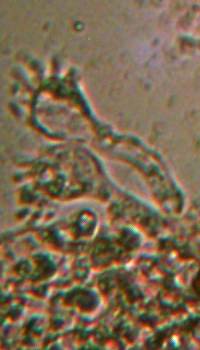 |
Cheilocystidia
Irregularly clavate, up to 35µm long, with thin 'stems' supporting remarkably long, forking 'medusa' heads.
Pleurocystidia
Absent. |
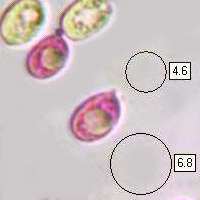 |
Spores
Ellipsoidal, smooth, 8-10 x 5-7µm; amyloid.
Spore print
White. |
Odour/taste |
Odour slightly farinaceous or rancid; taste not distinctive. |
Habitat & Ecological role |
Saprobic, nearly always on dead oak timber. |
Season |
June to November in Britain and Ireland. |
Similar species |
There are many other medium-sized, bell-shaped fungi in the Mycena genus including Mycena polygramma and Mycena arcangeliana; however, the iodine odour of the Mycena arcangeliana and the grooved stems of Mycena polygramma help to distinguish them from Mycena inclinata. |
Culinary Notes
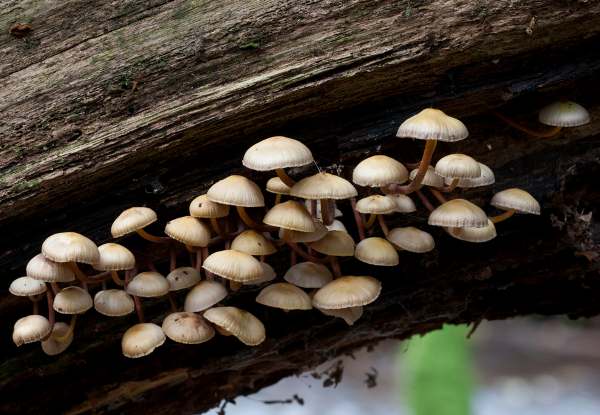
Although some field guides suggest that these little mushrooms may be edible, others express doubts. They are insubstantial and certainly not highly prized edibles, and so we recommend that the Clustered Bonnet is not considered as an edible mushroom.
Reference Sources
Fascinated by Fungi, 2nd Edition, Pat O'Reilly 2016, reprinted by Coch-y-bonddu Books in 2022.
Penny Cullington, (Oct. 2013). British Mycenas - Brief Descriptions.
Giovanni Robich, (2003). Mycena d'Europa; Associazione Micologica Bresadola ; Vicenza : Fondazione Centro Studi Micologici.
British Mycological Society. English Names for Fungi
Dictionary of the Fungi; Paul M. Kirk, Paul F. Cannon, David W. Minter and J. A. Stalpers; CABI, 2008
Taxonomic history and synonym information on these pages is drawn from many sources but in particular from the British Mycological Society's GB Checklist of Fungi.
Acknowledgements
This page includes pictures kindly contributed by David Kelly.
Top of page...
Fascinated by Fungi. Back by popular demand, Pat O'Reilly's best-selling 450-page hardback book is available now. The latest second edition was republished with a sparkling new cover design in September 2022 by Coch-y-Bonddu Books. Full details and copies are available from the publisher's online bookshop...